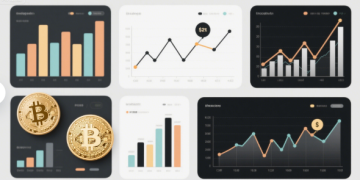In the ever-evolving cryptocurrency landscape, Bitcoin Token (BTCT) has emerged as a groundbreaking innovation that bridges Bitcoin’s foundational security with the flexibility of tokens. As the original cryptocurrency, Bitcoin has long been revered as “digital gold,” but Bitcoin Tokens are redefining its role, enabling decentralized finance (DeFi), non-fungible tokens (NFTs), and smart contracts. This article explores the technical underpinnings, real-world applications, and market dynamics of Bitcoin Token, highlighting why it’s a cornerstone of Bitcoin’s evolution.
What Is a Bitcoin Token?
A Bitcoin Token represents a digital asset or utility built on the Bitcoin blockchain. Unlike Bitcoin itself, which is primarily a store of value, these tokens can be programmed to serve diverse purposes. They leverage Bitcoin’s robust security while introducing functionalities like fractional ownership, automated transactions, and asset representation. For example, tokens can represent real-world assets (e.g., gold, real estate) or digital collectibles, all secured by Bitcoin’s immutable ledger.
Bitcoin Tokens are created through layer-2 solutions like the Lightning Network or sidechains like Stacks. These technologies enable off-chain transactions, reducing congestion and costs while maintaining Bitcoin’s security. For instance, Stacks uses a Proof of Transfer (PoX) consensus mechanism, allowing users to lock Bitcoin to earn STX tokens and participate in smart contract execution.
The Rise of Bitcoin Token in DeFi
Decentralized finance is one of Bitcoin Token’s most transformative use cases. By integrating Bitcoin into DeFi protocols, users can access lending, borrowing, and trading without relying on centralized intermediaries. Platforms like Sovryn, built on the Rootstock (RSK) sidechain, enable Bitcoin-backed loans with 0% interest, leveraging smart contracts to automate collateralization.
The Lightning Network further enhances DeFi by facilitating instant, low-cost transactions. For example, Strike, a Lightning-compatible app, allows users to send Bitcoin tips on Twitter instantly, demonstrating how Bitcoin Tokens can power microtransactions and real-time payments. As DeFi on Bitcoin matures, it’s attracting institutional interest, with projects like Twenty One Capital (backed by SoftBank) exploring Bitcoin-backed NFT derivatives and liquidity solutions.
Bitcoin Token and the NFT Revolution
NFTs have exploded in popularity, and Bitcoin Token is at the forefront of this movement. The Ordinals protocol, for instance, inscribes unique data (e.g., art, text) onto individual satoshis (Bitcoin’s smallest unit), creating NFT-like tokens directly on the Bitcoin blockchain. Projects like Node Monkes and Bitcoin Puppets have minted thousands of these digital collectibles, capitalizing on Bitcoin’s brand and security.
However, Bitcoin’s NFT ecosystem faces challenges, such as high transaction fees and limited scalability. Layer-2 solutions like Stacks and RSK are addressing these issues by enabling scalable NFT minting and trading. Stacks’ upcoming Nakamoto Release will introduce atomic swaps and decentralized Bitcoin pegs, further expanding NFT use cases. Meanwhile, Lightning Network’s micropayment channels could revolutionize NFT royalties by automating fractional payments to creators.

Technical Innovations Driving Bitcoin Token’s Growth
Bitcoin Token’s success hinges on advancements in Bitcoin’s infrastructure. The Lightning Network allows off-chain transactions, boosting throughput to millions of transactions per second while keeping fees negligible. This scalability is crucial for mass adoption, as seen in El Salvador’s national Bitcoin wallet, Chivo, which uses Lightning to facilitate cross-border payments.
Another key innovation is smart contract compatibility. Stacks’ Clarity programming language ensures predictable and secure smart contracts, enabling developers to build decentralized applications (dApps) on Bitcoin. Similarly, the Internet Computer (IC) integrates with Bitcoin at the protocol level, allowing canisters to hold and transfer Bitcoin natively. These developments are turning Bitcoin into a fully programmable platform, rivaling Ethereum in functionality.
Market Dynamics and Future Outlook
Bitcoin Token’s market performance reflects growing institutional and retail interest. As of June 2025, Bitcoin’s total market cap exceeds $2 trillion, solidifying its position as a top-tier asset. Concurrently, Bitcoin Token projects like Stacks (STX) have seen increased trading volumes, despite short-term price volatility.
Regulatory developments also shape the landscape. China’s revised anti-money laundering (AML) regulations, set to take effect by 2025, aim to address crypto-related risks, potentially influencing Bitcoin Token adoption in Asia. Meanwhile, the U.S. and Europe are exploring frameworks for digital assets, balancing innovation with consumer protection.
Looking ahead, Bitcoin Token is poised to become a critical component of Web3. Its integration with DeFi, NFTs, and enterprise solutions (e.g., supply chain tracking) will drive mainstream adoption. As projects like Twenty One Capital and Sovryn demonstrate, Bitcoin Token’s utility extends beyond speculation, offering tangible value in finance, art, and beyond.
Why Bitora Is Your Go-To Resource for Bitcoin Token Insights
At Bitora, we’re committed to delivering comprehensive, timely coverage of Bitcoin Token and the broader crypto ecosystem. Whether you’re an investor, developer, or enthusiast, our platform offers:
- Real-time market data: Track Bitcoin Token prices, volumes, and trends with our intuitive tools.
- In-depth analysis: Explore technical deep dives, regulatory updates, and emerging use cases.
- Community-driven content: Engage with experts and peers to stay ahead of the curve.
Stay informed, stay ahead—discover the future of Bitcoin Token with Bitora.
Stay ahead with Bitora’s crypto insights. Explore Bitcoin Token and other cutting-edge trends at Bitora.


























